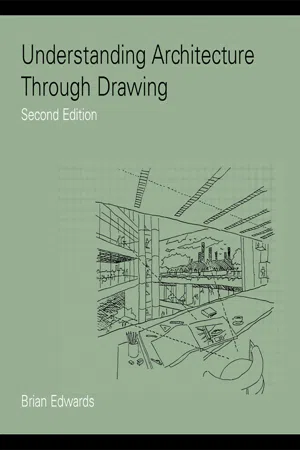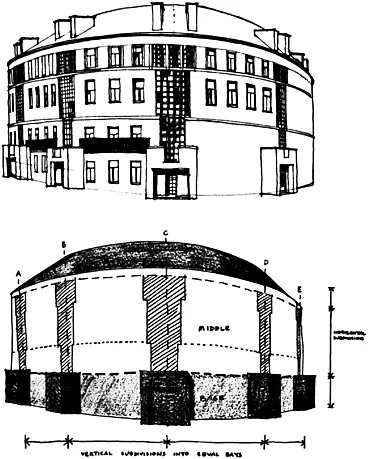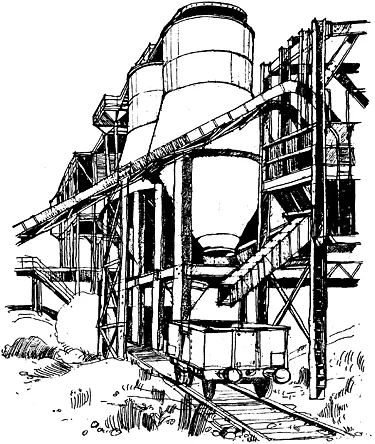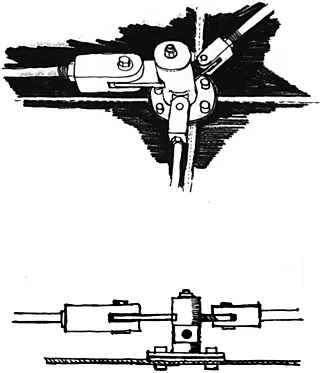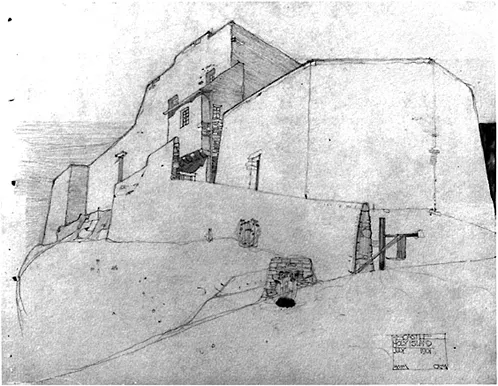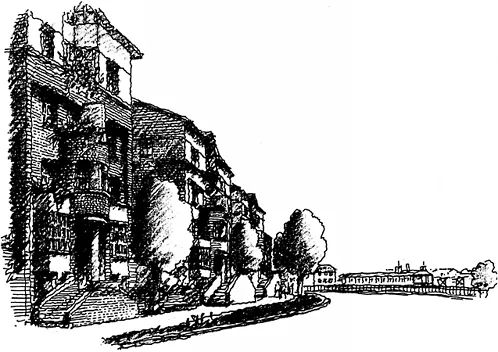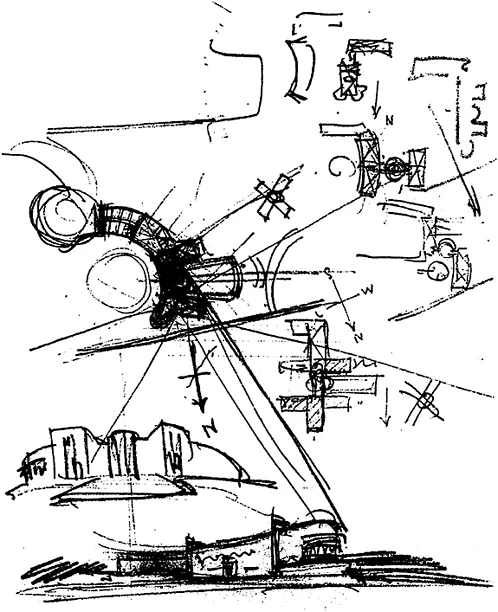Chapter 1
The benefits of drawing
The act of drawing is an important starting point for the intellectual process we call ‘design’. To be able to draw a chair or a building is a prerequisite for anyone wishing to design such things. Drawing has two functions for the designer – it allows him or her to record and to analyse existing examples, and the sketch provides the medium with which to test the appearance of some imagined object.
Before the advent of photography most architects kept a sketchbook in which they recorded the details of buildings, which they could refer to when designing. The fruits of the Grand Tour or more local wanderings consisted of drawn material supported, perhaps, by written information or surveyed dimensions.
The sketchbook provided a form of research and a library of plans and details to crib at a later stage. Because the architect is not necessarily aiming only at documentary representation, the sketches were often searching and analytical. Many of the drawings prepared found their way into later designs. The English architect C.R. Cockerell used pocket-sized sketchbooks and filled them with drawings not only of sites in Italy and Greece, but also of cities in Britain. His sketchbooks, which survive at the Royal Institute of British Architects (RIBA), show that a direct link existed between Cockerell’s field studies and his commissions as an architect. Later architects such as Alvar Aalto, Le Corbusier and Louis Kahn employed the sketchbook in a similar fashion, though to different ends. Lord Foster (opposite) continues with this tradition.
Drawings have been used by architects in many different ways. Ranging between the opposite poles of the freehand drawing as a record and as a design tool exist many different applications for the designer. Some architects use the sketch as the main means of communicating a design idea to clients. Such sketches relay the thinking behind a proposal as well as suggesting a tangible form. Other architects use the sketch to analyse townscape and to indicate how their design will fit into the street. Others use the sketch as a method of studying building typology, using the analysis as a way of placing their design into known precedents. However the sketch is employed, the main point is to use the freehand drawing as a design tool, as a method of giving form and expression to one’s thoughts. One may finish the design process with a formal perspective, but that end product should not be where sketching begins. Design analysis through the freehand drawing should be at the start of the creative process, not at the end, and preferably before the design commission arrives in the first place. The sketchbook is a personal library; it needs to be built up so that it can become a basis for later, undreamt of, designs.
1.1 This sketch (dated 1862) by Richard Norman Shaw of Bidborough in Kent shows his interest in vernacular buildings. It is no surprise to find Shaw designing new buildings in similar spirit at the time. (RIBA Drawings Collection)
1.2 This drawing of a new circular tenement built in Glasgow in 1990 highlights the pattern of windows and shows how the stairways have been used to articulate the design. The sketch seeks to explain the basic geometry of the circular tenement. By eliminating all detail the proportions have become clearer, and what is not evident in the sketch has been highlighted in the notes.
1.3 The sculptural massing is evident in this disused colliery at Chislet in Kent.
Many architects’ drawings leave out a great deal of detail. Whether a sketch is of a design proposal or an existing reality, the element of removal or abstraction is one of the characteristics of such drawings. It is better to capture the essence rather than seek an exhaustive realism. Designers need to know what to leave suggested rather than explicitly recorded. The principles and truth that such drawings seek to communicate can be hidden by too much detail or graphic bombardment. A good drawing is one that leaves room for imaginative interpretation. These principles apply equally to a page in the sketchbook or a drawing prepared to highlight a design proposal.
Sketching and freehand drawing have for too long been seen as the point of entry into painting, as against the essential starting point for design. Art colleges have, of course, always maintained a sketchbook tradition among artists and designers alike, but in sixth-form colleges, and even schools of architecture, the sketchbook has been usurped by the computer simulation or verbal description.
What this book seeks to revive is the sketch and analytical drawing as means of understanding form and construction. Only through the study of existing examples – not laboriously drawn but critically examined – can we cultivate a nation of people sensitive to design and its application to our everyday environment. This willingness to learn from past examples should apply across the board, from an appreciation of townscapes to the design of children’s furniture.
1.4 Glazing details are not always as expressive as here at the Financial Times printing works (designed by Nicholas Grimshaw and Partners) in East London. Notice how the sketch is supplemented by a freehand section.
1.5 The windows of the Pump Room in Bath make an attractive pattern from both the inside and outside. As with much Georgian architecture, elements such as shop fronts and sash windows are framed with margins and mouldings.
1.6 Charles Rennie Mackintosh possessed a unique vision which embraced not only his freehand drawings and watercolours, but also his designs as an architect. This sketch (dated 1901) by him of the castle at Holy Island in Northumberland is similar in spirit to his more adventurous designs, especially in the three-dimensional treatment of gables. (Glasgow University: Mackintosh Collection)
Questions of scale are hardly relevant – we live in a designed environment, whether we as consumers are aware of it or not. Every lamp standard and traffic sign has been ‘designed’, the layout of motorway junctions has been shaped by an engineer with an eye to beauty as well as safety. On a smaller scale, our cutlery and crockery are designed, as are the disposable wrappings at the fast-food restaurant.
The sketchbook allows us to be aware of this reality as long as students are encouraged to explore through drawing. The welcome changes to the national curriculum to enhance the status of design and craft teaching, and the broadening of appeal of courses in architecture, landscape design and town planning, have created an unprecedented interest in the environment and design. To turn this interest into a better-designed world requires the development of graphic and visual skills.
In a sense we are all designers, even if we do not make our living through the medium of design. As designers we modify our immediate environment through changing the decor of our houses, or designing our own clothes, to choosing consumer objects on the basis of how they look as well as how they work. We are sold products and services partly by design – you have only to watch television advertising to realise that our aesthetic sensibilities are being appealed to even when the product being promoted is as unglamorous as double glazing.
1.7 The Daily Express Building, Glasgow, built in 1936, expresses the material sleekness of International Modernism.
1.8 This sketch by the architect Richard Reid sets his design proposals for Gravesend in Kent into the streetscape. This type of exploratory sketch is part of the process most architects employ to test the apperance of their ideas.
Prince Charles has awakened the national consciousness over questions of urban quality and architectural design. He uses the sketchbook as a means of describing and understanding the places he likes. The sketch is employed as a learning tool rather than as mere description.
The untrained eye can learn a great deal through drawing. It teaches an important visual discipline – an awareness of shape, line and perspective. The sketch also engenders respect for the environment and the designed objects within it. To have sat for an hour and drawn an old panelled door is to create a respect for the object that may discourage the tendency to daub it with graffiti, or to relegate it to firewood. Such doors could be recycled if their qualities or beauty were respected, and the sketch rather than the instantly obtained photograph is the means to this awareness.
1.9 At the level of house design, sketches by the architect Sir Basil Spence explore options for the general arrangement of the plan. Spence relates the plan to how the house will look from afar. The design is for Gribloch near Glasgow, built in 1938. (NMRS: Spence Collection)
It is said that in our modern world we now produce more photographs than bricks. For the first time in history the visual image has become more prevalent than the means of making houses. The lesson concerns the importance of design and appearance in contemporary society. But photographs are not always the most appropriate medium for expressing this visual concern. There are times, and subjects, which lend themselves to graphic analysis, rather than pictorial description. This book has the aim of reviving the sketchbook tradition, in order to create a visually literate society. The objective of education is to achieve not just literacy and numeracy, but graphic, visual and spatial skills. Our success as an industrial society requires this; and so do we, whether as designers or as individuals.
If this book encourages people – professional designers or otherwise – to explore the environment round about them with sketchbook and pencil (as against camera) in hand, then a useful beginning would have been made. There are always subjects to learn from, whether we choose to live in city, suburb or countryside. This book takes themes based upon everyday experience, and seeks to draw design lessons from them. Once we have learnt the language of drawing and graphic analysis, we are then in a position to engage in the complex business of design. For the first time in history design involves us all and has permeated through to every aspect of our lives. If we ignore the language of design, we will be as disadvantaged as those who finish school without the basic skills of literacy and numeracy. No single book can teach us how to learn through drawing, but it can point us in the right direction and open our eyes to the benefit of good design.
TYPES OF DRAWING
To the architect and urban designer there are three main types of freehand drawing. The first is the elaborate perspective drawing used to communicate design ideas to clients or planning authorities. Increasingly this type of drawing is produced by computer. The second type concerns the production of sketch perspectives and views used to communicate design ideas to specialists such as engineers, and sometimes to help clarify points for the designer’s own benefit. This type of drawing can be split into:
- the investigation of an early design;
- exploring methods of construction;
- testing the visual effect of details;
- setting the design in its physical context.
The third type of freehand drawing concerns the exploration of the existing world, its buildings, details and landscapes. The use of drawing in this regard does not just provide a repertoire of forms and designs to use in developing new structures, but helps cultivate a sensitivity towards the existing context in which architects, planners and landscape architects are increasingly required to work.
Of these three broad categories of drawing, this book focuses upon the latter. With a growing awareness of the cultural and aesthetic values of cities, and with the European Community requiring ever-higher standards of urban design, those in the environmental professions face new challenges.
The general public, too, are better informed and through local amenity societies and bodies like the National Trust make their views known on an unprecedented scale. The widening of education to embrace design and technology (under the national curriculum reforms of 1990) promises to focus yet more attention upon design in public fields such as architecture. Hence the world of the professions has been opened to challenge by an informed public, with design no longer the monopoly of people with letters after their names.
Before the modern design professions were established, students and practitioners employed the sketchbook as a matter of course. They were not topographical artists but people in search of creative material. The Arts and Crafts architect George Devey studied under John Sell Cotman in Norwich in the 1830s, thereby absorbing not just Cotman’s approach to freehand drawing, but a whole collection of details of windmills, barns, country houses, castles and cottages which later proved invaluable to Devey the architect. Similarly, Richard Norman Shaw, Ernest George, John Keppie and, later, Edwin Lutyens continued to use the sketchbook to record the towns and buildings not just of Britain, but of Europe and the Middle East. One can trace the origins of the architectural sketchbook back to the Renaissance, but its blossoming as a creative force in its own right owes much to the nineteenth century.
The sketchbook is a personal record – a dialogue between artist and subject. The nature of the dialogue determines the quality or use of the finished drawing. By engaging in the subject, the artist, architect or student develops a sensitivity and understanding difficult to obtain by other means. The blind copying of subject is not necessarily useful – a critical stance is required. One may never use the sketch produced of the town or landscape –at least not directly – but, like reading a good book, the insights gained may prove invaluable later on.
The designer needs to be accomplished in the three main areas of drawing mentioned earlier. To be able to render a convincing perspective is an essential skill; to explore the detailing of an unbuilt structure through sketches avoids pitfalls in the final design; and to use freehand drawing to learn from past examples helps the architect or urban designer to give better shape to townscapes of the future. The environmental awareness that is a feature of our post-industrial society has encouraged a return to questions of firmness,...
